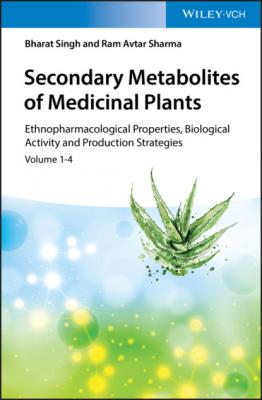Secondary Metabolites of Medicinal Plants. Bharat Singh
Читать онлайн.| Название | Secondary Metabolites of Medicinal Plants |
|---|---|
| Автор произведения | Bharat Singh |
| Жанр | Химия |
| Серия | |
| Издательство | Химия |
| Год выпуска | 0 |
| isbn | 9783527825592 |
2.17.2 Culture Conditions
The callus cultures were established with different growth regulators (benzylaminopurine (BAP), naphthaleneacetic acid (NAA) and indole-3-butyric acid (IBA); 2,4-dichlorophenoxyacetic acid (2,4-D) and benzylaminopurine) in B. pinnatum (Gurnani et al. 2014). The cultures were incubated in the darkness at 24 ± 1 °C for 50 days. The percentage of callus induction and the area of explants covered by callus cells were evaluated. The highest percentage of callus induction was 100%, obtained with the combination of 2,4-D and benzyl adenine (BA) (Santos et al. 2014).
References
1 Afzal, M., Gupta, G., Kazmi, I. et al. (2012). Anti-inflammatory and analgesic potential of a novel steroidal derivative from Bryophyllum pinnatum. Fitoterapia 83: 853–858.
2 Akihisa, T., Kokke, W.C.M., Tamura, T., and Matsumoto, M. (1991). Sterols of Kalanchoe pinnata: first report of the isolation of both C-24 epimers of 24-alkyl-Δ25-sterols from a higher plant. Lipids 26: 660–665.
3 Akinpelu, D.A. (2000). Anti-microbial activity of Bryophyllum pinnatum leaves. Fitoterapia 71: 193–194.
4 Almedia, A.P. and Costa, S.S. (2006). 1-Octane-3-O-α-l-arabinopyranosyl-(16)-glucopyranoside, a minor constituent from leaves of Kalanchoe pinnata. Braz. J. Pharmacogn. 16: 485–489.
5 Anderson, L.A.P., Steyn, P.S., and van Heerden, F.R. (1984). The characterization of two novel bufadienolides, lanceotoxins A and B from Kalanchoe lanceolata [Forssk]. J. Chem. Soc., Perkin Trans. 1 0: 1573–1575.
6 Anjoo, K. and Kumar, S.A. (2010). Microscopical and preliminary phytochemical studies on aerial part (leaves and stem) of Bryophyllum pinnatum Kurz. Pharmacogn. J. 2: 254–259.
7 Asolkar, L.V., Kakkar, K.K., and Chakre, O.J. (1992). Second Supplement to Glossary of Indian Medicinal Plants with Active Principles, Part I (A–K). New Delhi: CSIR.
8 Bapuji, J.L. and Ratnam, S.V. (2009). Traditional uses of some medicinal plants by tribals of Gangaraju Madugula Mandal of Visakhapatnam District, Andhra Pradesh. Ethnobot. Leafl. 13: 388–398.
9 Belayneh, A. and Bussa, N.F. (2014). Ethnomedicinal plants used to treat human ailments in the prehistoric place of Harla and Dengego valleys, eastern Ethiopia. J. Ethnobiol. Ethnomed. 10: 18.
10 Betschart, C., von Mandach, U., Seifert, B. et al. (2013). Randomized, double-blind placebo-controlled trial with Bryophyllum pinnatum versus placebo for the treatment of overactive bladder in postmenopausal women. Phytomedicine 20: 351–358.
11 Bussmann, R.W. (2006). Ethnobotany of the Samburu of Mt. Nyiru, South Turkana, Kenya. J. Ethnobiol. Ethnomed. 2: 35.
12 Capon, R.J., MacLeod, J.K., and Oelrichs, P.B. (1986). Bryotoxins B and C, toxic bufadienolide orthoacetates from the flowers of Bryophyllum tubiflorum (Crassulaceae). Aust. J. Chem. 39: 1711–1715.
13 Chopra, R.N., Nayer, S.L., and Chopra, I.C. (1992). Glossary of Indian Medicinal Plants. New Delhi: CSIR.
14 Da Silva, S.A., Costa, S.S., Mendonca, S.C. et al. (1995). Therapeutic effect of oral Kalanchoe Pinnata leaf extract in murine leishmaniasis. Acta Trop. 60: 201–210.
15 Deb, J. and Dash, G.K. (2013). Kalanchoe laciniata (L.) DC: a lesser known Indian medicinal plant. Int. J. Sci. Inventions Today 2: 158–162.
16 El Abdellaoui, S., Destandau, E., Toribio, A. et al. (2010). Bioactive molecules in Kalanchoe pinnata leaves: extraction, purification, and identification. Anal. Bioanal. Chem. 398: 1329–1338.
17 Fürer, K., Eberli, D., Betschart, C. et al. (2015). Inhibition of porcine destrusor contractibility by the flavonoid fraction of Bryophyllum pinnatum – a potential phytotherapeutic drug for the treatment of the overactive bladder syndrome. Phytomedicine 22: 158–164.
18 Fürer, K., Raith, M., Brenneisen, R. et al. (2013). Two new flavonol glycosides and a metabolic profile of Bryophyllum pinnatum, a phytotherapeutic used in obstetrics and gynaecology. Planta Med. 79: 1565–1571.
19 Gaind, K.N. and Gupta, R.L. (1973). Phenolic components from the leaves of Kalanchoe pinnata. Planta Med. 23: 149–153.
20 Gupta, S. and Banerjee, R. (2011). Radical scavenging potential of phenolics from Bryophyllum pinnatum (LamM.) Oken. Prep. Biochem. Biotechnol. 41: 305–319.
21 Gurnani, C., Kumar, V., Mukhija, S. et al. (2014). Conservation of medicinal plant Bryophyllum pinnatum (Lam.) Kurz by in vitro nodal culture. Int. J. Pharm. Sci. Res. 5: 2406–2411.
22 Huang, H.C., Lin, M.K., and Yang, H.L. (2013). Cardenolides and bufadienolide glycosides from Kalanchoe tubiflora and evaluation of cytotoxicity. Planta Med. 79: 1362–1369.
23 Huang, K.C. (1993). The Pharmacology of Chinese Herbs. Boca Raton, FL: CRC Press.
24 Kamboj, A. and Saluja, A.K. (2009). Bryophyllum pinnatum (Lam.) Kurz.: phytochemical and pharmacological profile: a review. Pharmacogn. Rev. 3: 364–374.
25 Karuppusamy, S. (2007). Medicinal plants used by Paliyan tribes of Sirumalai hills of Southern India. Nat. Prod. Radiance 6: 436–442.
26 Kipkore, W., Wanjohi, B., and Rono, H. (2014). A study of the medicinal plants used by the Marakwet community in Kenya. J. Ethnobiol. Ethnomed. 10: 24.
27 Kirtikar,
